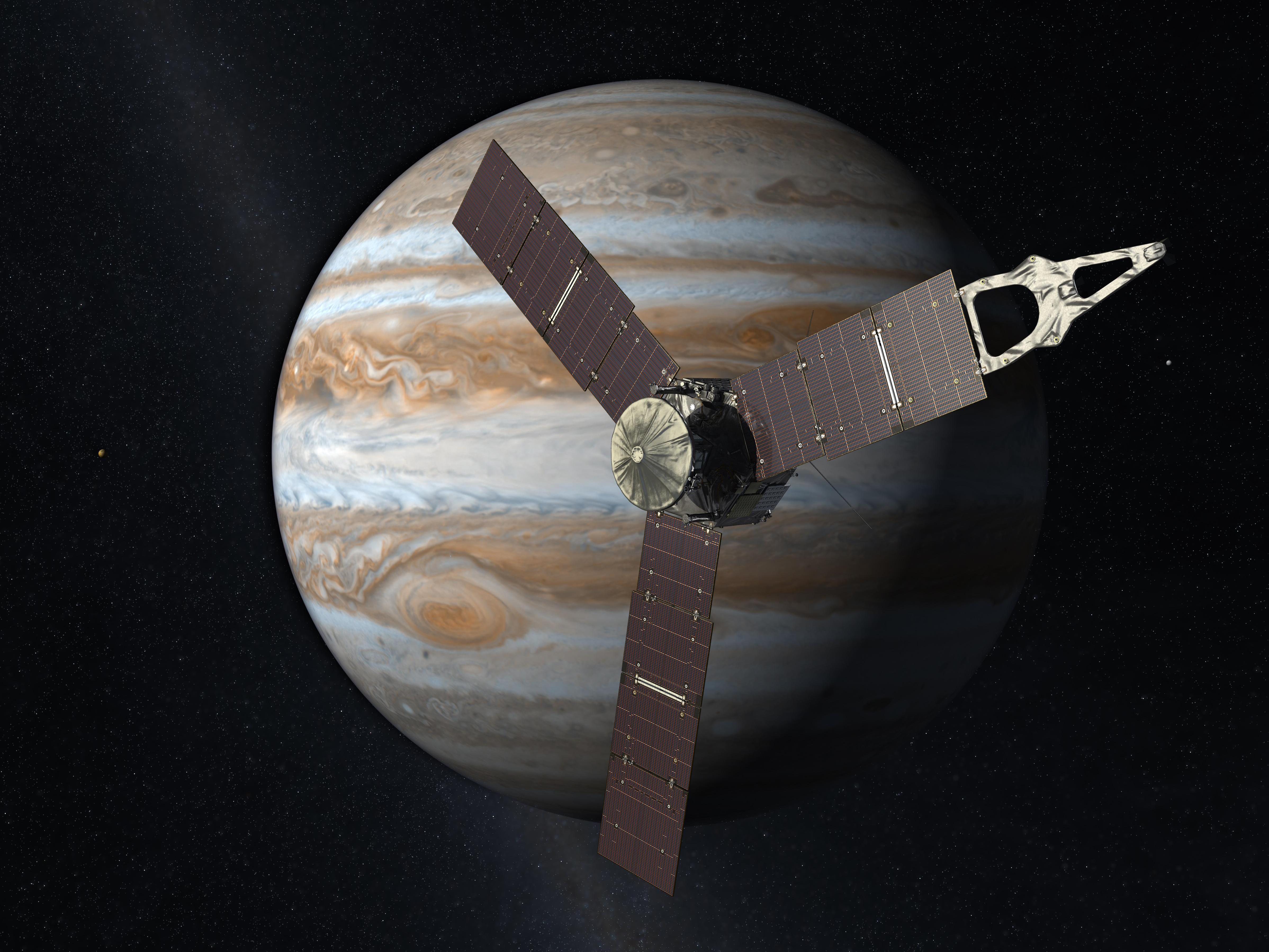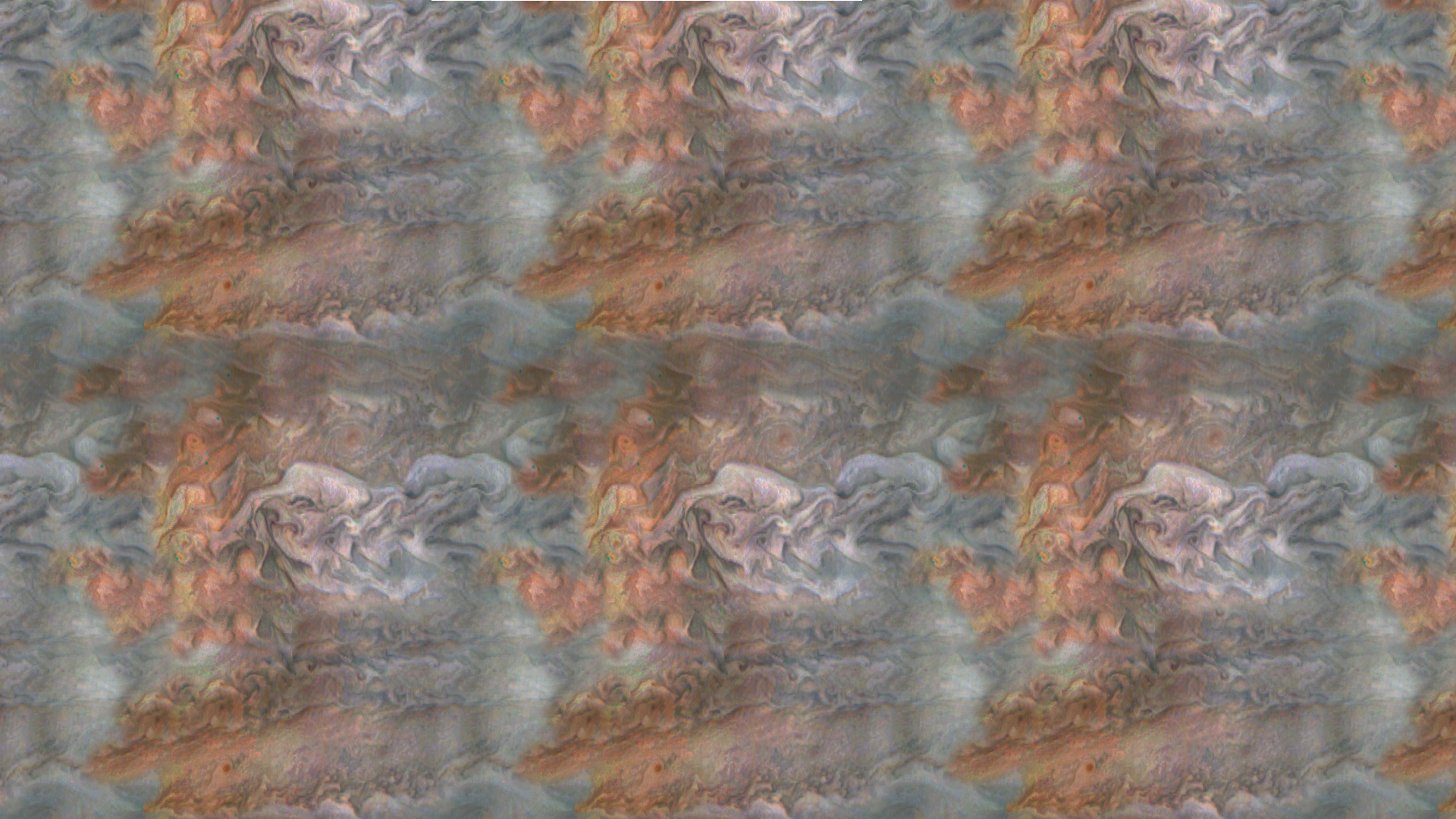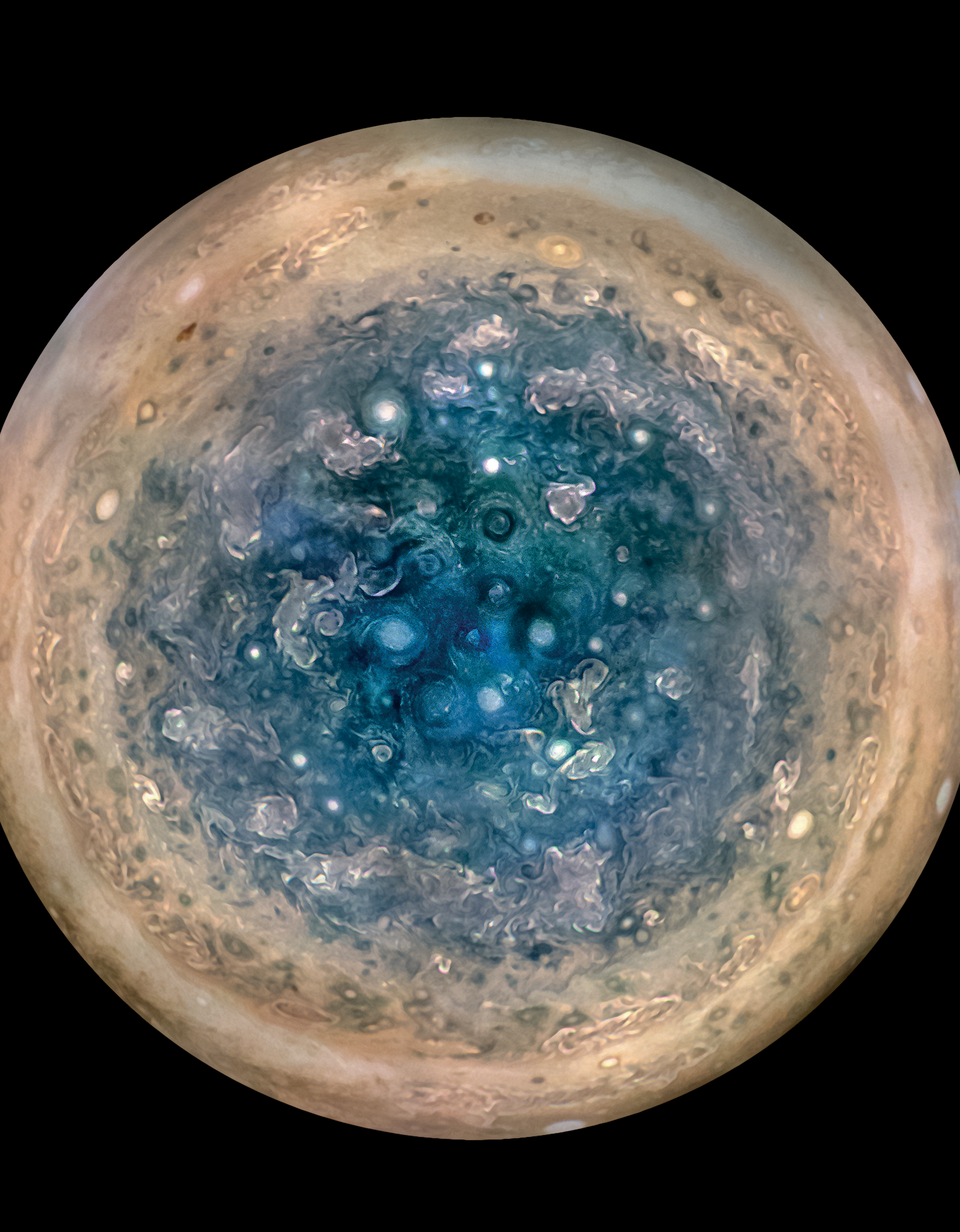
June 2, 2017, by Brigitte Nerlich
Juno, Jupiter and the art of citizen science
With political and moral life here on earth being in utter turmoil, images of/from Jupiter beamed down to our little planet by the Juno space probe have recently kept me sane (as far as that’s possible). They brought with them glimpses of beauty and moments of wistfulness.
A year or so ago, I wrote a blog post about Juno, the space probe, and Jupiter, the planet, when Juno was approaching Jupiter. There you can find some more info on the mission. In this post I just wanted to marvel at some of the images which Juno managed to beam down to us. While doing this, I found something out about these pictures that I didn’t know! (And the scientists pouring over them found out that there is lots they don’t know about Jupiter!)
Marbled paper, wallpaper and famous paintings
First I saw this image of Jupiter’s cloud tops (on twitter). It reminded me of a special type of paper used in old books! In the case of Jupiter the marbling occurs naturally but I wonder whether there is some overlap in the physical and chemical processes involved. If you want to know more about the extremely interesting culture and science of marbling, read on here.
The subtitle for this marvellous marbling image says: “This enhanced color view of Jupiter’s cloud tops was processed by citizen scientist Bjorn Jonsson using data from the JunoCam instrument on NASA’s Juno spacecraft. The image highlights a massive counterclockwise rotating storm that appears as a white oval in the gas giant’s southern hemisphere.”(bold added) Credits: NASA/JPL-Caltech/SwRI/MSSS/Bjorn Jonsson
When initially searching for this image in order to put in this post, I also found another one (or rather, it seems, the same, but rendered differently). I came across it in a blog post that asked whether people associated it with Van Gogh’s ‘Starry Night’, or, indeed, cotton candy.
The subtitle to this image says: “The swirling clouds on Jupiter, shown in an image captured by the JunoCam instrument on the Juno spacecraft, and processed by citizen scientist Roman Tkachenko.” (bold added) Credit: Roman Tkachenko/NASA
From these sub-titles and from the blog post in which this last image was used, I learned that these images are produced by citizen scientists, or rather, as I’d call them citizen science-artists. The blog post explains: “The raw images that JunoCam sends back to Earth usually don’t look like much, but they contain information that can be extracted with imaging processing and color correcting. The resulting images can highlight particular features in the cloud tops, or re-create what the planet might look like to human eyes up close. Most of the work that has gone into processing the JunoCam images has been done by citizen scientists. The JunoCam team posts the raw image files online, and anyone can take them, process them and post the final result on the JunoCam website. Some users do extreme processing, creating amazing works of art, while others work on the images in such a way as to reveal new features and assist in the pursuit of knowledge about this planet.”
When searching for the first image, I also found yet another image called “Jupiter wallpaper”
The description below this image says (I have left out paragraphs): “When team members from NASA’s Juno mission invited the public to process JunoCam images, they did not anticipate that they would receive back such beautiful, creative expressions of art. The oranges and grayed-out regions of blue-green in this tiled and color-enhanced image resemble a color scheme much like Romantic era paintings, but more abstract. The lack of discreet objects to focus on allows the mind to seek familiar Earthly shapes, and the brightest spots seem to draw the eye. Eric Jorgensen created this Jovian artwork with a JunoCam image taken when the spacecraft was at an altitude of 11,100 miles (17,800 kilometers) above Jupiter’s cloudtops on Dec. 11, 2016 at 9:22 a.m. PT (12:22 p.m. ET).” (bold added)
I hadn’t realised how much citizen-science art goes into the creation of these images! Popular images of galaxies beamed down by the Hubble space telescope are usually artistically rendered by NASA scientists, as far as I know. They have been studied for the way they get their colouring inspirations from Romantic paintings, for example. This type of analysis should also be carried out for these citizen-science-artists. One might even want to ask them about where they get their inspiration from!
Those interested in this topic can read Elizabeth Kessler’s book Picturing the Cosmos or Coloring the Universe by Travis Rector, Kimberly Arcand, and Megan Watzke.
A glittering geode and a song
After marvelling at these marbling images, I then saw in image of Jupiter’s south pole that was truly stunning and quite different. It reminded me of the geodes I collected with my father many years ago. These “are spherical rocks that contain hollow cavities lined with crystals. The name geode comes from the Greek word Geoides, which means ‘earthlike.'” For me, there is nothing earth-like about this one though (apart from its shape); but it’s certainly a jewel.
The subtitle for this image reads: “This image shows Jupiter’s south pole, as seen by NASA’s Juno spacecraft from an altitude of 32,000 miles (52,000 kilometers). The oval features are cyclones, up to 600 miles (1,000 kilometers) in diameter. Multiple images taken with the JunoCam instrument on three separate orbits were combined to show all areas in daylight, enhanced color, and stereographic projection.” Credits: NASA/JPL-Caltech/SwRI/MSSS/Betsy Asher Hall/Gervasio Robles (I am not totally sure who Betsy Asher Hall and Gervasio Robles are, but a related image of the south pole was created by citizen scientist Gabriel Fiset.)
This image also reminded me of some verses of the song “Starry, starry night”, namely: “Starry, starry night; Flaming flowers that brightly blaze; Swirling clouds and violet haze”. Other people may have other associations, of course. A “blue marble, shimmering with swirling gold sand“, perhaps…
Is that Orion that I see before me?
The last image I came across before drafting this post was of Orion, my favourite constellation, but seen from a totally different angle, namely, through the ring of Jupiter – I could see Orion from another world!
The description explains: “As NASA’s Juno spacecraft flew through the narrow gap between Jupiter’s radiation belts and the planet during its first science flyby, Perijove 1, on August 27, 2016, the Stellar Reference Unit (SRU-1) star camera collected the first image of Jupiter’s ring taken from the inside looking out. The bright bands in the center of the image are the main ring of Jupiter’s ring system. While taking the ring image, the SRU was viewing the constellation Orion. The bright star above the main ring is Betelgeuse, and Orion’s belt can be seen in the lower right.” Credits: NASA/JPL-Caltech/SwRI
All this brought to mind (yet again) the oft-quoted passage from Immanuel Kant’s Critique of Practical Reason (1788): “Two things fill the mind with ever new and increasing admiration and reverence, the more often and more steadily one reflects on them: the starry heavens above me and the moral law within me.” I just wish that more people would make that connection between the starry heavens above them, which we can now view in every-increasing detail, and the moral law within them, of which we are losing sight.
Science, art and citizens
It is interesting that these images the Juno gave us of Jupiter are so other-worldly, but at the same time we feel so at home in them. This is partly because we make these images in our image. We render the unfamiliar familiar by seeing the images of the starry heavens above us through the lenses of art and culture. These images are not just marvels of science and technology. They are also products of our imagination. This imagination, which feeds art and science alike, is shared by scientists and citizens and, of course, citizen scientists/artists. It should be shared as widely as possible among us citizens of the world.
Public participation in the Juno mission is actively encouraged. As Calla Cofield at Space.com points out: “The JunoCam project not only lets citizen scientists process Juno’s raw data and create amazing images, but also welcomes citizens to vote on which features JunoCam should photograph during each flyby.” And “The creators of the JunoCam outreach program wanted to ‘involve the public in every aspect of what an imaging team would ordinarily be doing,’ according to Candy Hansen, a Juno co-investigator and head of the JunoCam team.” Go to the JunoCam website for further information- participate, create, share and communicate!
Featured image: Wikimedia commons
No comments yet, fill out a comment to be the first






Leave a Reply